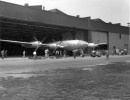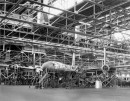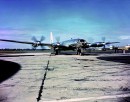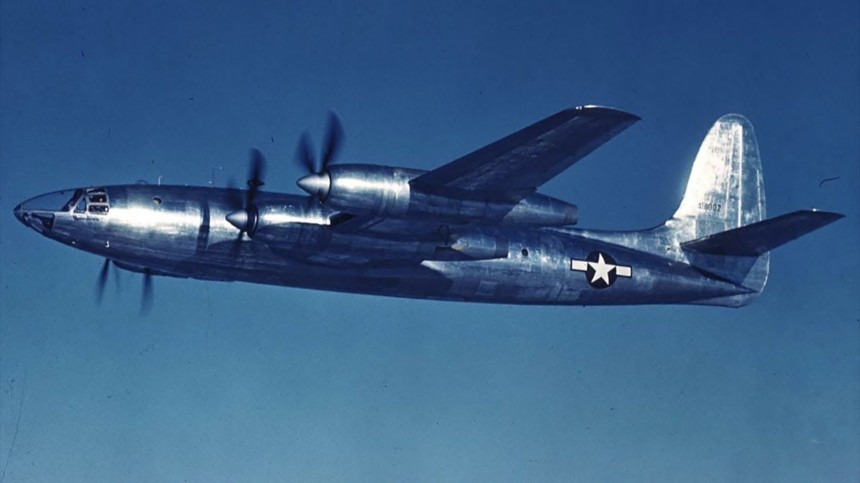By the end of World War II, piston-engine military airplanes were already on their way out. But like early 90s grunge rock before mainstream pop took over, the Republic XF-12 Rainbow showed piston engines could still power an impressive airframe right before their final swansong. For the people working at Republic Aviation, the Rainbow was perhaps the most notable highlight the public has almost no idea even existed. In short, it's their best-kept secret.
When most people think of Republic Aviation, they invariably only think of the P-47 Thunderbolt of Second World War fame. Of course, the Thunderbolt was the ugly muscle behind the P-51 Mustang's grace and beauty. But to say there was nothing built in between the piston-powered P-47 and the turbojet F-84 Thunderjet would also be inaccurate. In the immediate aftermath of World War II, the last of the superprops had their final days in the spotlight.
Icons of the time like the Hawker Sea Fury, the Arsenal VB-10, the Grumman F8F Bearcat, and a handful of others represented the absolute zenith of piston military aircraft. But among all of these, there's an argument to be made the Republic Rainbow was more impressive than all others. In truth, the XF-12 Rainbow's development stems all the way back to the war.
In 1943, the United States Army Air Force's Air Technical Service Command issued a design proposal for a novel form of military aircraft. A speeding bullet of an airframe that could perform long overflights of the Japanese home islands from bases in the South Pacific or fly over the heart of German-occupied Europe via the United Kingdom. Such a design wouldn't be there to drop bombs but rather to take pictures for photo reconnaissance purposes.
With arguably an even more vital role to play than a dedicated fighter or strategic bomber, the USAAF's requested photo-recon plane needed to fly fast, at high altitudes, with the ability to escape in a pinch. At that point in the war, the only aircraft even remotely suited for that job was the photo-recon variant of the Lockheed P-38 Lightning, the F-5. But by President Franklin D. Roosevelt's son Elliot's own admission as a USAAF Colonel specializing in reconnaissance, the F-5 was still insufficient for the job.
Ultimately, two American design teams took on the proposal for what the USAAF required. Two polarly opposite design philosophies from two radically different minds ultimately resulted. On the one hand, there was the Hughes XF-11, a twin-engine, twin-boom multirole aircraft most famous for re-arranging Howard Hughes's organs when the thing crashed after an engine failure.
But on Republic's side of things, the XF-12 Rainbow looked like a B-17 Flying Fortress after a high-carb, high-protein diet and eighteen months of an LA Fitness membership. With dimensions of 93 feet and ten inches (28.59 m) long and a 129-foot, two-inch (39.36 m) wingspan, the Rainbow is actually a little bit bigger than a Flying Fortress, more so straddling the middle ground between the B-17 and larger bombers like the B-29 Superfortress.
In spite of its size, lightweight build materials like aluminum alloy kept the XF-12's weight at reasonable levels. Completely empty, the Republic Rainbow weighed a mere 65,000 lbs (29,484 kg). Meaning the rest of the aircraft's 101,400 lb (45,994 kg) gross weight fully loaded is taken up by crew and payload. Lofting all this heft into the sky would be four of the most bonkers piston radial engines ever designed, the Pratt & Whitney R-4360 Wasp Major.
With 4,362.5 cubic inches (71.5 L) of displacement and 28 cylinders arranged in massive banks of four rows, the Wasp Major was one of the ultimate evolutions of military piston engines. With 3,250 horsepower each to work with, the Republic Rainbow managed the proverbial hat trick of accomplishment piston engine aircraft could achieve. The ability to fly at 400 miles per hour (644 kph) and cruise at 40,000 feet (12,192 m) over 4,000 miles (6,400 km) via four engines allowed the Republic Rainbow to fly "on all fours."
The XF-12 Rainbow was developed at Republic Aviation's primary production facility in the town of Farmingdale in Long Island, New York. The same factory that birthed the P-47 but also the A-10 Thunderbolt II. The doors to the hangar in which the Rainbow was being developed had to be modified in order to accommodate its high-mounted vertical stabilizer. With a first test flight in February 1946, the Rainbow flew in the immediate aftermath of the Second World War.
The XF-12 flew with a suite of photography equipment that even Walt Disney would find impressive. Complete with a dark room for photo development, photos could be completely developed by the time the mission was over. On top of that, performance figures were right in line with expectations, never something you could bank on in the days before computer models.
But it wasn't enough. No sooner did the XF-12 make its first flight was the first generation of American jet fighters usurping piston engine aircraft in military roles. As a result, no orders were put forth for the XF-12 by the U.S. Army Air Force, a move upheld when the USAAF was reorganized into the U.S. Air Force we're all familiar with. Though the XF-12 was all but dead as a military project, hope existed it could be reimagined as an airliner.
On the face of it, the XF-12 looked like a perfect fit for airliner service. A large, slender fuselage with room for at least as many seats as a typical Douglas DC-4 or Boeing 314 of the day. It was thought a redesigned XF-12-based airliner dubbed in concept as the RC-2 could fly higher, faster, and in far more luxury than a contemporary piston airliner. Almost taking on a "Concorde of the late 1940s" image in design studies.
But just the same as in military applications, the coming of turbine jet engine power in the civilian airline sector via the de Havilland Comet, Boeing 707, and Tupolev Tu-104 rendered the Republic RC-2 as redundant as the two XF-12s that managed to make it out of the Farmingdale facility. In the end, both XF-12 prototypes were scrapped.
The only living memory of this remarkable airplane's creation is the modification to its hangar in Farmingdale. Today, this hangar is operated by a private company neighboring the American Air Power Museum, located in the adjacent hangar. To this day, museum tour guides will still point out that notch in the hangar doors of the adjacent hangar building and remark it was added to house a remarkable experimental Republic Aircraft that was built there. If only museum-goers knew how much of an understatement that was.
Icons of the time like the Hawker Sea Fury, the Arsenal VB-10, the Grumman F8F Bearcat, and a handful of others represented the absolute zenith of piston military aircraft. But among all of these, there's an argument to be made the Republic Rainbow was more impressive than all others. In truth, the XF-12 Rainbow's development stems all the way back to the war.
In 1943, the United States Army Air Force's Air Technical Service Command issued a design proposal for a novel form of military aircraft. A speeding bullet of an airframe that could perform long overflights of the Japanese home islands from bases in the South Pacific or fly over the heart of German-occupied Europe via the United Kingdom. Such a design wouldn't be there to drop bombs but rather to take pictures for photo reconnaissance purposes.
With arguably an even more vital role to play than a dedicated fighter or strategic bomber, the USAAF's requested photo-recon plane needed to fly fast, at high altitudes, with the ability to escape in a pinch. At that point in the war, the only aircraft even remotely suited for that job was the photo-recon variant of the Lockheed P-38 Lightning, the F-5. But by President Franklin D. Roosevelt's son Elliot's own admission as a USAAF Colonel specializing in reconnaissance, the F-5 was still insufficient for the job.
But on Republic's side of things, the XF-12 Rainbow looked like a B-17 Flying Fortress after a high-carb, high-protein diet and eighteen months of an LA Fitness membership. With dimensions of 93 feet and ten inches (28.59 m) long and a 129-foot, two-inch (39.36 m) wingspan, the Rainbow is actually a little bit bigger than a Flying Fortress, more so straddling the middle ground between the B-17 and larger bombers like the B-29 Superfortress.
In spite of its size, lightweight build materials like aluminum alloy kept the XF-12's weight at reasonable levels. Completely empty, the Republic Rainbow weighed a mere 65,000 lbs (29,484 kg). Meaning the rest of the aircraft's 101,400 lb (45,994 kg) gross weight fully loaded is taken up by crew and payload. Lofting all this heft into the sky would be four of the most bonkers piston radial engines ever designed, the Pratt & Whitney R-4360 Wasp Major.
With 4,362.5 cubic inches (71.5 L) of displacement and 28 cylinders arranged in massive banks of four rows, the Wasp Major was one of the ultimate evolutions of military piston engines. With 3,250 horsepower each to work with, the Republic Rainbow managed the proverbial hat trick of accomplishment piston engine aircraft could achieve. The ability to fly at 400 miles per hour (644 kph) and cruise at 40,000 feet (12,192 m) over 4,000 miles (6,400 km) via four engines allowed the Republic Rainbow to fly "on all fours."
The XF-12 flew with a suite of photography equipment that even Walt Disney would find impressive. Complete with a dark room for photo development, photos could be completely developed by the time the mission was over. On top of that, performance figures were right in line with expectations, never something you could bank on in the days before computer models.
But it wasn't enough. No sooner did the XF-12 make its first flight was the first generation of American jet fighters usurping piston engine aircraft in military roles. As a result, no orders were put forth for the XF-12 by the U.S. Army Air Force, a move upheld when the USAAF was reorganized into the U.S. Air Force we're all familiar with. Though the XF-12 was all but dead as a military project, hope existed it could be reimagined as an airliner.
On the face of it, the XF-12 looked like a perfect fit for airliner service. A large, slender fuselage with room for at least as many seats as a typical Douglas DC-4 or Boeing 314 of the day. It was thought a redesigned XF-12-based airliner dubbed in concept as the RC-2 could fly higher, faster, and in far more luxury than a contemporary piston airliner. Almost taking on a "Concorde of the late 1940s" image in design studies.
The only living memory of this remarkable airplane's creation is the modification to its hangar in Farmingdale. Today, this hangar is operated by a private company neighboring the American Air Power Museum, located in the adjacent hangar. To this day, museum tour guides will still point out that notch in the hangar doors of the adjacent hangar building and remark it was added to house a remarkable experimental Republic Aircraft that was built there. If only museum-goers knew how much of an understatement that was.















